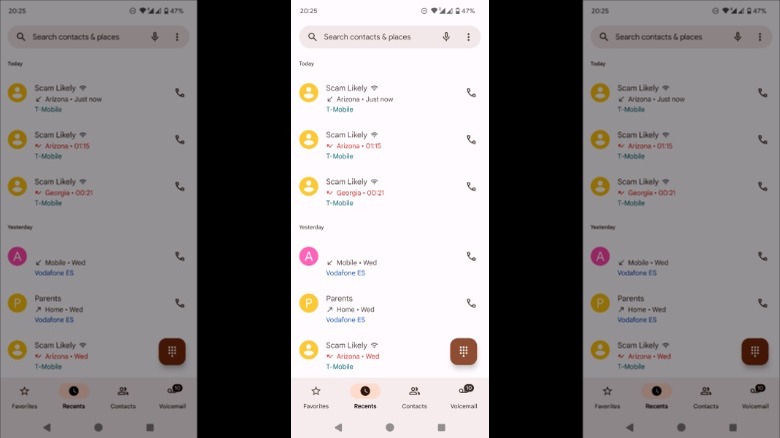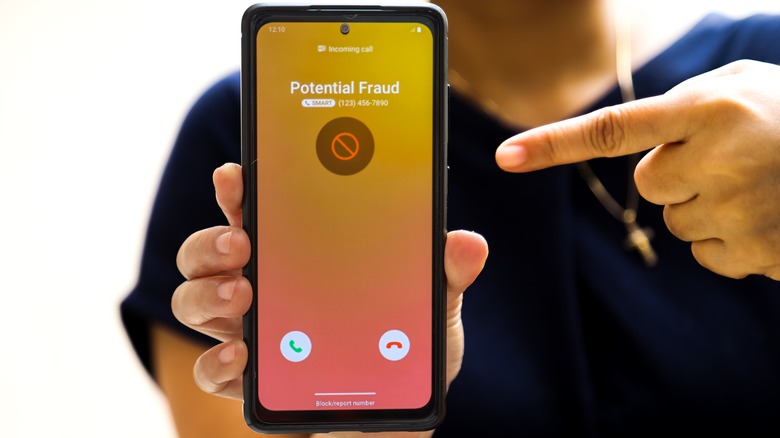How To Block Scam Likely Calls: A Step-By-Step Guide
It's something that's happened to us all: we reach for our phone to answer a call only to see the words "scam likely" on the screen. As more people move to messaging as their primary means of keeping in touch with family and friends, it's not uncommon to feel like you get more potential scam calls than legitimate ones. While telecommunications companies have developed advanced algorithms to identify many of these annoying calls, some still slip through the cracks, leaving us vulnerable to con artists trying to steal our money or trick us into revealing personal information.
Scammers have devised all sorts of methods to evade detection, including taking advantage of VoIP technology and caller ID spoofing to mask their identity. Although the Federal Communications Commission has taken steps to protect consumers, including levying hefty fines on companies caught engaging in these practices, as anyone with a phone knows, there seems to be no end to scam calls. So, it's up to you, as a consumer, to be proactive about protecting yourself.
How to use your carrier's app to block scam likely calls
When it comes to boosting our phone's security, there are a seemingly limitless number of tools and apps to help. All major carriers — T-Mobile, Verizon, and AT&T — have apps specifically designed to help stop "scam likely" calls in their tracks. With features like real-time call screening, spam alerts, and blocking unwanted callers, these apps can serve as your first line of defense against scammers.
Block Spam Calls With T-Mobile Scam Shield App:
- Download the Scam Shield App for Apple or Android.
- Log in using your T-Mobile account.
- Activate Scam Block to block scam calls automatically.
- Customization: Use the app to manage blocklists and enable enhanced caller ID.
Block Spam Calls With the AT&T ActiveArmor App:
- Download the AT&T ActiveArmor app for Apple or Android.
- Log in with your AT&T credentials.
- Enable the call-blocking feature.
- Customization: Set up custom call controls and block specific numbers through the app.
Block Spam Calls With the Verizon Call Filter App:
- Download the Verizon Call Filter app for Apple or Android.
- Sign in with your Verizon account.
- Turn on spam detection and call filtering.
- Customization: Create a personal blocklist and adjust spam sensitivity settings.
These apps provide comprehensive protection from scam calls, including advanced features to identify and block them. They come with customization options, allowing you to tailor them to your needs and providing an extra layer of protection against these calls.
How to use your phone's built-in call blocking features
Another way to reduce the number of scam calls you receive is by using your phone's built-in call-blocking features. Once you or your carrier have identified a number as a likely scam, you can block it on your phone to prevent it from calling you again.
Block calls on your iPhone:
- Open the Phone app.
- Go to the Recents tab.
- Find the number you want to block.
- Tap the "i" icon next to the number.
- Scroll down to Block this Caller.
Manage Blocked numbers on your iPhone:
- Go to Settings.
- Scroll down and tap Phone.
- Select Blocked Contacts to view and edit your list.
Block calls on your Android:
- Open the Phone app.
- Tap on "Recents."
- Find the number you want to block.
- Long press the number.
- Tap "Block/report spam."
- Select "Block" at the bottom of the dialogue box.
Manage Blocked numbers on your Android phone:
- Open the Phone app.
- Tap on the three dots in the upper right-hand corner of the screen.
- Select settings from the drop-down menu.
- Scroll down to "Blocked numbers" to view and edit your list.
The main limitation of built-in call-blocking features is the scammer's phone call may get through the first time. Remember that scammers often change numbers, making it difficult to keep your block list up to date.
Use third-party apps to keep scammers away
As you already know, it's impossible to block every "spam likely" call you receive manually. Luckily, third-party apps can make the task more manageable by doing the heavy lifting for you. Apps like Hiya and Truecaller offer enhanced features and a broader database to identify and block scam calls. These apps take a crowdsourced approach to identifying scammers, allowing users to report scams and spam numbers. Once a number is reported multiple times, it's added to the app's database as a potential threat.
This community-based method means these lists are constantly updated, making the apps very effective for real-time identification. They also use the latest technology, including machine-learning algorithms, to analyze calling patterns and behaviors. Over time, they learn to identify characteristics common to scam calls, such as frequent number changes or short call durations.
These apps give you complete control over who to block. You can block all incoming numbers that aren't in your phone's contacts, block only numbers flagged as high risk, or create a personalized block list. Some apps let users allow list specific numbers to ensure important calls are never mistakenly blocked.



